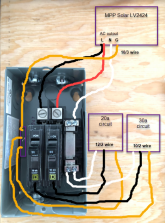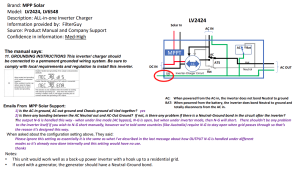Hi Everyone!
I'm a newb solar guy building my first portable solar generator using an MPP Solar LV2424 all-in-one inverter box, and two 12v 100ah batteries in series.
I have a couple questions though, maybe someone here can help or offer advice:
1) With this setup, is a breaker box required or good to use? Or does this all-in-one unit already have cover-current protection?
2) If it needs a breaker box, is my wiring diagram correct? Any changes or something not right?
Thanks in advance! -Chris.

I'm a newb solar guy building my first portable solar generator using an MPP Solar LV2424 all-in-one inverter box, and two 12v 100ah batteries in series.
I have a couple questions though, maybe someone here can help or offer advice:
1) With this setup, is a breaker box required or good to use? Or does this all-in-one unit already have cover-current protection?
2) If it needs a breaker box, is my wiring diagram correct? Any changes or something not right?
Thanks in advance! -Chris.





